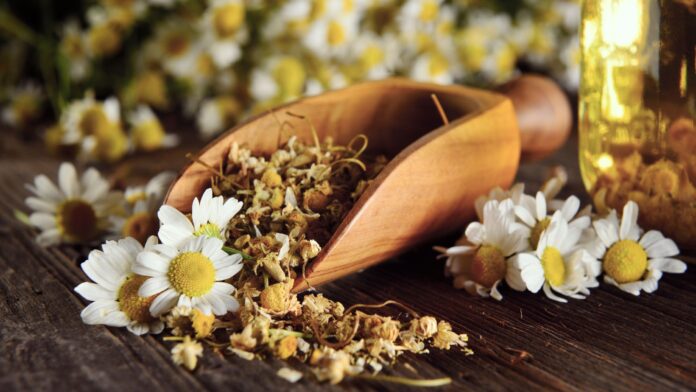Understanding German Chamomile
Historical and Cultural Significance
Chamomile has a rich history and cultural significance that spans across various civilizations and eras. Historically, chamomile was revered by the ancient Egyptians, who dedicated it to their sun god, Ra, and used it in the embalming process. The Greeks and Romans also valued chamomile for its medicinal properties, utilizing it to treat a range of ailments from digestive issues to inflammation.
During the Middle Ages, chamomile became a staple in European herbal medicine. It was commonly used in monasteries and by herbalists to prepare remedies for fevers, skin conditions, and respiratory problems. Its soothing properties made it a popular choice for teas and poultices.
In folk traditions, chamomile has been associated with notions of relaxation and tranquility. It was often used in rituals and charms to promote restful sleep and ward off negative energies. Chamomile’s cultural significance is also evident in its frequent appearance in literature and art, symbolizing calmness and healing.
Botanical Profile: Differences Between German and Roman Chamomile
German chamomile (Matricaria chamomilla), also known as wild chamomile, and Roman chamomile (Chamaemelum nobile), also known as English chamomile, are two distinct species that share similarities but have notable differences in their botanical profiles.
German chamomile is an annual plant, meaning it completes its life cycle within one growing season. It typically grows up to 60 centimeters (24 inches) tall and has branching stems with finely divided, feathery leaves. The flowers of German chamomile are daisy-like, with white petals surrounding a conical yellow center. This species is known for its sweet, apple-like fragrance.
In contrast, Roman chamomile is a perennial plant, which means it lives for more than two years. It tends to be shorter than German chamomile, growing to a height of about 30 centimeters (12 inches). Roman chamomile has similar daisy-like flowers, but its petals are more spaced out, and the plant has a low, creeping growth habit, making it suitable as a ground cover. Its fragrance is often described as more robust and earthy compared to German chamomile.
Both species contain beneficial compounds, but the concentration and types of active constituents can vary. German chamomile is particularly rich in chamazulene and bisabolol, which contribute to its anti-inflammatory and calming properties. Roman chamomile, on the other hand, is noted for its higher content of esters like angelate and tiglate, which have calming and anti-spasmodic effects.
Common Uses: Therapeutic, Culinary, and Cosmetic
Therapeutic Uses
Chamomile is renowned for its therapeutic benefits, particularly in the realm of herbal medicine. German chamomile is frequently used to make herbal teas that help soothe digestive issues, reduce anxiety, and promote sleep. Its anti-inflammatory properties make it effective in treating skin conditions such as eczema, dermatitis, and minor wounds. Chamomile essential oil, extracted from the flowers, is often used in aromatherapy to alleviate stress and enhance relaxation.
Roman chamomile shares many of these therapeutic uses but is particularly favored for its muscle-relaxing and antispasmodic properties. It is commonly used to relieve menstrual cramps, muscle spasms, and tension headaches. Both species are gentle enough to be used in remedies for children, particularly for teething pain and colic.
Culinary Uses
Chamomile is also used in the culinary world, though its role is more subtle compared to its medicinal applications. The dried flowers of German chamomile are used to brew herbal teas, often blended with other herbs and flowers to enhance flavor and health benefits. Chamomile tea is not only consumed for its calming effects but also used in cooking and baking. It can be infused into syrups, jellies, and desserts, imparting a delicate floral flavor.
Roman chamomile is less commonly used in culinary applications but can still be found in some traditional recipes. Its flowers and leaves can be used as a garnish or infused into herbal vinegar.
Cosmetic Uses
Chamomile’s soothing and anti-inflammatory properties make it a valuable ingredient in the cosmetic industry. German chamomile extract is widely used in skincare products designed to calm irritated skin, reduce redness, and promote healing. It is commonly found in creams, lotions, and facial mists.
Roman chamomile is also used in cosmetics, particularly in products aimed at sensitive skin. Its essential oil is added to bath products, shampoos, and conditioners to provide a calming and soothing effect. Chamomile is also used in hair care to enhance blonde highlights and add shine.
In conclusion, German chamomile and Roman chamomile, while distinct in their botanical characteristics, both offer a wide range of therapeutic, culinary, and cosmetic benefits. Their historical and cultural significance underscores their enduring popularity and value across various domains. Whether used as a herbal remedy, a culinary ingredient, or a cosmetic component, chamomile continues to be cherished for its versatile and beneficial properties.
Starting Chamomile from Seed
Best Time to Plant Chamomile Seeds
Chamomile seeds should be planted at a time that ensures optimal growth and development. The best time to plant chamomile seeds is in the early spring, after the danger of frost has passed. This timing allows the seeds to germinate and grow during the cool and mild temperatures of spring, which are ideal for their development. In regions with mild winters, chamomile can also be sown in the fall for a late winter or early spring harvest.
Soil Preparation and Requirements
Preparing the soil properly is crucial for the successful growth of chamomile. Chamomile prefers well-drained, sandy loam soil with a pH range of 5.6 to 7.5. To prepare the soil, start by removing any weeds and debris from the planting area. Loosen the soil to a depth of about 6 inches and incorporate organic matter, such as compost, to improve soil structure and fertility.
In-Ground Growing
When growing chamomile in the ground, ensure the soil is loose and well-aerated to prevent waterlogging. Chamomile does not tolerate heavy, clayey soils that retain too much moisture. Raised beds can be a good option if the garden soil is not ideal, as they provide better drainage and root development conditions.
Container Growing
For container growing, choose a pot that is at least 8-10 inches deep with adequate drainage holes. Use a high-quality potting mix that includes sand or perlite to enhance drainage. Container growing is suitable for small spaces and allows for easy movement and management of the plants.
Seeding Techniques for Optimal Germination
Chamomile seeds are very small and require careful handling to ensure successful germination. Follow these steps for optimal results:
- Surface Sowing: Scatter the seeds thinly on the soil surface. Do not cover the seeds with soil, as they need light to germinate.
- Pressing Seeds: Gently press the seeds into the soil using a flat board or your hand to ensure good seed-to-soil contact.
- Watering: Water the area lightly to avoid washing away the seeds. Keep the soil consistently moist but not waterlogged during the germination period.
Light, Temperature, and Moisture Conditions
Chamomile seeds require specific conditions to germinate and thrive:
- Light: Chamomile seeds need exposure to light to germinate. Ensure they are planted in a location that receives full sun to partial shade. If growing indoors, place the containers near a bright window or use grow lights.
- Temperature: The ideal temperature for chamomile seed germination is between 60-68°F (15-20°C). Maintaining this temperature range will promote uniform germination.
- Moisture: Consistent moisture is key during the germination period. Keep the soil surface evenly moist but avoid waterlogging, which can lead to fungal diseases. Once the seedlings emerge, reduce watering slightly to prevent damping-off.
In conclusion, starting chamomile from seed involves careful attention to timing, soil preparation, seeding techniques, and environmental conditions. By following these guidelines, you can successfully grow healthy chamomile plants that will provide therapeutic, culinary, and cosmetic benefits. Whether growing in the ground or containers, chamomile can be a rewarding addition to any garden.
Plant Care and Maintenance
German chamomile (Matricaria chamomilla) is a popular herb known for its delicate, daisy-like flowers and its use in teas and natural remedies. While it’s relatively easy to grow, understanding its specific needs will help you cultivate healthy plants with abundant blooms. This guide covers everything you need to know about watering, weeding, dealing with pests and diseases, and fertilizing your German chamomile plants.
Watering Requirements and Techniques
German chamomile is fairly drought-tolerant once established, but it requires consistent moisture during its early growth stages to thrive.
Watering Requirements:
- Seedlings: When starting from seeds, keep the soil consistently moist but not waterlogged. Seedlings are delicate and need regular watering to establish strong roots.
- Mature Plants: Once established, German chamomile prefers moderate watering. The soil should be kept slightly moist, but allowing it to dry out a bit between waterings encourages deeper root growth. Aim to water your chamomile about once a week, adjusting based on rainfall and the specific conditions in your garden.
Watering Techniques:
- Drip Irrigation: Drip irrigation is ideal for chamomile, as it delivers water directly to the root zone without wetting the foliage. This method helps prevent fungal diseases and ensures that the roots get the moisture they need.
- Soaker Hoses: If you don’t have a drip irrigation system, soaker hoses are another good option. Lay the hose at the base of the plants and let it run until the soil is evenly moist.
- Hand Watering: If you hand-water your plants, do so in the early morning to allow time for the foliage to dry during the day, which helps prevent fungal issues. Water at the base of the plants rather than from above to minimize splashing soil onto the leaves.
The Importance of Weeding and How to Do It Effectively
Weeding is crucial for the health of German chamomile, especially in the early stages of growth when competition from weeds can hinder its development.
Importance of Weeding:
- Reduced Competition: Weeds compete with chamomile for water, nutrients, and sunlight. Keeping the area around your plants weed-free ensures they have access to the resources they need to grow strong and healthy.
- Disease Prevention: Weeds can harbor pests and diseases that might spread to your chamomile plants. Regular weeding reduces the chances of these issues.
- Improved Air Circulation: Removing weeds improves air circulation around your chamomile plants, which can help prevent fungal diseases.
Effective Weeding Techniques:
- Hand Weeding: For small areas, hand weeding is the most effective method. Gently pull weeds from the base, making sure to remove the entire root system to prevent regrowth. Chamomile has shallow roots, so be careful not to disturb the plants while weeding.
- Mulching: Applying a layer of mulch around your chamomile plants can significantly reduce weed growth. Organic mulches like straw, wood chips, or compost are ideal. Mulch also helps retain soil moisture and regulate soil temperature.
- Hoeing: In larger garden beds, use a hoe to remove weeds. Hoeing is best done when weeds are small, as it cuts them off at the soil line. Be gentle around your chamomile plants to avoid damaging their shallow roots.
Dealing with Common Pests and Diseases
While German chamomile is relatively hardy, it can still fall victim to certain pests and diseases. Early detection and management are key to keeping your plants healthy.
Common Pests:
- Aphids: These small, soft-bodied insects can cluster on the undersides of leaves, sucking sap and weakening the plant. To control aphids, use a strong spray of water to knock them off the plants, or apply insecticidal soap.
- Spider Mites: These tiny pests can cause yellowing and speckling of leaves. They thrive in hot, dry conditions. Increase humidity around the plants by misting them, and consider introducing beneficial insects like ladybugs to control mite populations.
- Cutworms: Cutworms can damage young chamomile plants by severing them at the base. Protect seedlings with collars made from cardboard or aluminum foil, placed around the stem at soil level.
Common Diseases:
- Powdery Mildew: This fungal disease appears as a white, powdery coating on the leaves. It thrives in humid conditions with poor air circulation. To prevent powdery mildew, ensure your plants have good spacing for air circulation, water at the base of the plants, and avoid overhead watering. If powdery mildew appears, remove affected leaves and apply a fungicide if necessary.
- Damping-Off: This is a common issue with seedlings, where young plants suddenly wilt and die due to soil-borne fungi. To prevent damping-off, ensure good soil drainage, avoid overwatering, and start seeds in sterile soil.
- Root Rot: Overwatering or poorly drained soil can lead to root rot, where the plant’s roots begin to decay. To prevent this, avoid waterlogged conditions and ensure your soil has good drainage.
When and How to Fertilize
German chamomile doesn’t require heavy fertilization, but providing the right nutrients at the right time can boost its growth and flowering.
When to Fertilize:
- Before Planting: If your soil is low in organic matter, work in compost or well-rotted manure before planting to improve soil fertility.
- During Growth: Apply a balanced, all-purpose fertilizer (such as a 10-10-10 formula) once during the growing season, typically when the plants are about 6 inches tall and starting to produce flower buds. Over-fertilizing can lead to lush foliage with fewer flowers, so use fertilizer sparingly.
How to Fertilize:
- Liquid Fertilizer: If you’re using a liquid fertilizer, dilute it according to the instructions and apply it directly to the soil around the base of the plants. Avoid getting fertilizer on the leaves, as this can cause burns.
- Granular Fertilizer: For granular fertilizers, scatter the granules around the base of the plants and lightly work them into the soil with a rake or your hands. Water the area well after applying to help the fertilizer reach the roots.
- Compost Tea: As an alternative, consider using compost tea, which is gentle and provides nutrients in a form that’s easy for the plants to absorb. Apply compost tea every 2-3 weeks during the growing season.
Harvesting Chamomile
German chamomile (Matricaria chamomilla) is prized for its delicate, aromatic flowers, which are commonly used in teas, essential oils, and natural remedies. To get the most out of your chamomile plants, it’s important to know when and how to harvest the flowers correctly. This guide will cover everything you need to know about the harvesting process, including signs that chamomile is ready for harvest, techniques for harvesting flowers to maximize yield and quality, and how to handle fresh chamomile post-harvest.
Signs That Chamomile Is Ready for Harvest
Knowing when to harvest chamomile is crucial for obtaining the best flavor and potency from the flowers.
Flower Appearance:
The key indicator that chamomile is ready for harvest is the appearance of the flowers. Look for fully open blooms with white petals that are flat or slightly downward-facing. The center of the flower, called the disc, should be bright yellow. If the petals start to curl backward, it means the flowers are past their prime, though they are still usable.
Timing:
Chamomile flowers are best harvested in the morning after the dew has dried but before the heat of the day. This is when the essential oils in the flowers are at their peak, ensuring the best flavor and potency.
Regular Monitoring:
Chamomile blooms continuously throughout the growing season, so regular monitoring is important. Check your plants every few days, as new flowers will keep appearing. This allows for multiple harvests, maximizing your yield.
Techniques for Harvesting Chamomile Flowers
Proper harvesting techniques are essential to ensure you get the best quality flowers and to encourage the plant to produce more blooms.
Hand Harvesting:
The most common method for harvesting chamomile is by hand. To do this:
- Gently grasp the flower head between your thumb and forefinger.
- Pinch the stem just below the flower head and pull gently to snap it off.
- Alternatively, you can use small scissors or garden snips to cut the flower heads just below the base.
Using a Rake:
For larger chamomile plantings, you can use a small rake or chamomile comb designed for harvesting flowers:
- Lightly rake through the tops of the plants, which will pull off the flower heads while leaving the stems intact.
- This method can be quicker but may result in some flowers that are less than perfect. If you’re harvesting for high-quality teas or oils, hand-picking is preferable.
Maximizing Yield:
To maximize yield, harvest the flowers regularly. The more you pick, the more the plant will produce. Aim to harvest every 7-10 days during peak blooming season. Be careful not to damage the plant’s foliage, as this can reduce its ability to produce more flowers.
Avoid Harvesting Wet Flowers:
Never harvest chamomile flowers when they are wet from rain or dew. Wet flowers are more susceptible to mold and mildew during drying and storage.
How to Handle Fresh Chamomile Post-Harvest
Once you’ve harvested your chamomile flowers, proper handling is crucial to preserve their quality and extend their shelf life.
Drying Chamomile:
Drying is the most common way to preserve chamomile flowers for later use. Here’s how to do it effectively:
- Air Drying: Spread the flowers out in a single layer on a mesh screen, a clean cloth, or a paper towel. Place them in a well-ventilated, dry area away from direct sunlight. It can take 1-2 weeks for the flowers to dry completely, depending on the humidity levels.
- Dehydrator: If you have a food dehydrator, you can use it to dry chamomile more quickly. Set the dehydrator to a low temperature (95-100°F) and dry the flowers until they are crisp and crumbly.
- Oven Drying: Another option is to dry the flowers in the oven on its lowest setting, with the door slightly ajar to allow moisture to escape. Spread the flowers on a baking sheet and dry them for 2-4 hours, checking frequently to ensure they don’t overheat.
Storing Dried Chamomile:
Once your chamomile flowers are fully dried, store them in an airtight container, such as a glass jar with a tight-fitting lid. Keep the container in a cool, dark place, away from heat and moisture. Properly dried and stored chamomile can last for up to a year while retaining its flavor and medicinal properties.
Using Fresh Chamomile:
If you plan to use fresh chamomile flowers immediately, you can skip the drying process. Fresh flowers can be used in teas, infused oils, or even as a garnish. However, fresh chamomile has a shorter shelf life, so it’s best to use it within a day or two of harvesting.
Making Chamomile Tea:
To make a simple fresh chamomile tea:
- Rinse the flowers gently under cool water to remove any dirt or insects.
- Place a handful of fresh flowers into a teapot or mug.
- Pour hot (not boiling) water over the flowers and let steep for 5-10 minutes.
- Strain the flowers and enjoy your tea. Fresh chamomile tea has a more delicate flavor than dried, with subtle, sweet notes.
Infusing Chamomile in Oil:
Chamomile-infused oil is great for skin care and can be used in homemade lotions, balms, and salves:
- Fill a clean, dry jar with fresh chamomile flowers.
- Pour a carrier oil (like olive oil or jojoba oil) over the flowers until they are completely submerged.
- Seal the jar and place it in a sunny spot for 2-4 weeks, shaking it gently every few days.
- Strain the flowers from the oil and store the infused oil in a dark, cool place.
Using German Chamomile
Chamomile is a versatile herb that goes far beyond its well-known use in herbal teas. With its soothing properties, pleasant aroma, and delicate flavor, chamomile can be incorporated into a wide range of homemade products and recipes. In this guide, we’ll explore how to make chamomile tea, use chamomile in skincare products, and even cook with this wonderful herb.
Making Chamomile Tea: Recipes and Tips
Chamomile tea is one of the most popular herbal teas in the world, known for its calming effects and mild, pleasant flavor. Making chamomile tea at home is simple, and you can customize it to your taste.
Basic Chamomile Tea Recipe:
- Ingredients:
- 2 teaspoons of dried chamomile flowers (or 2 tablespoons of fresh chamomile flowers)
- 1 cup of hot water
- Honey, lemon, or other flavorings (optional)
- Instructions:
- Place the chamomile flowers in a teapot or mug.
- Pour hot water over the flowers. Ensure the water is hot but not boiling, as boiling water can cause the delicate flavors to become bitter.
- Let the tea steep for 5-10 minutes, depending on how strong you like it.
- Strain the flowers out of the tea using a fine mesh strainer or tea infuser.
- Sweeten with honey or add a slice of lemon if desired. Enjoy your relaxing cup of chamomile tea!
Tips for Brewing the Perfect Cup:
- Adjusting Strength: If you prefer a stronger tea, use more chamomile flowers or allow the tea to steep longer. For a milder tea, reduce the steeping time or use fewer flowers.
- Mixing with Other Herbs: Chamomile pairs well with other herbs like lavender, mint, or lemon balm. Experiment by adding a small amount of these herbs to your tea for a unique flavor profile.
- Cold Brew: Chamomile tea can also be enjoyed cold. To make cold-brew chamomile tea, simply steep the flowers in cold water in the refrigerator for 12-24 hours. Strain and serve over ice.
Chamomile in Skincare: Creating Homemade Products
Chamomile’s anti-inflammatory and soothing properties make it a fantastic ingredient in homemade skincare products. Whether you’re looking to soothe irritated skin, reduce redness, or simply enjoy the calming scent, chamomile can be a key ingredient in your DIY skincare routine.
Chamomile-Infused Oil: Chamomile-infused oil can be used on its own or as a base for other skincare products like lotions, balms, and serums.
- Ingredients:
- 1 cup dried chamomile flowers
- 1 cup carrier oil (such as olive oil, jojoba oil, or sweet almond oil)
- Instructions:
- Place the dried chamomile flowers in a clean, dry jar.
- Pour the carrier oil over the flowers, ensuring they are fully submerged.
- Seal the jar tightly and place it in a sunny spot for 2-4 weeks, shaking gently every few days.
- After the infusion period, strain the flowers from the oil using a fine mesh strainer or cheesecloth.
- Store the chamomile-infused oil in a dark, cool place. It can be used directly on the skin or incorporated into other homemade products.
Chamomile Face Toner: This soothing toner is perfect for calming irritated skin and can be used as part of your daily skincare routine.
- Ingredients:
- 1 cup brewed chamomile tea (cooled)
- 1 tablespoon witch hazel
- A few drops of essential oil (optional, such as lavender or tea tree)
- Instructions:
- Brew a strong cup of chamomile tea and let it cool completely.
- Mix the cooled tea with witch hazel in a clean spray bottle or jar.
- Add a few drops of essential oil if desired.
- Apply the toner to your face with a cotton pad or spray it directly onto your skin. Store in the refrigerator for up to a week.
Chamomile Bath Soak: A chamomile bath soak is a luxurious way to unwind and soothe your skin after a long day.
- Ingredients:
- 1/2 cup dried chamomile flowers
- 1/2 cup Epsom salt
- 1/4 cup baking soda
- A few drops of essential oil (optional, such as lavender or eucalyptus)
- Instructions:
- Mix the chamomile flowers, Epsom salt, and baking soda in a bowl.
- Add the mixture to a muslin bag or tie it up in a piece of cheesecloth.
- Place the bag in your bath under warm running water. Let it steep in the tub for a few minutes before getting in.
- Soak for at least 20 minutes, enjoying the soothing properties of the chamomile.
Cooking with Chamomile: Culinary Uses and Recipes
Chamomile isn’t just for tea—it can also add a unique flavor to a variety of culinary dishes. Its mild, floral notes make it a wonderful addition to both sweet and savory recipes.
Chamomile-Infused Honey: Chamomile-infused honey is a delightful way to add flavor to teas, desserts, and even savory dishes.
- Ingredients:
- 1/2 cup dried chamomile flowers
- 1 cup honey
- Instructions:
- Place the chamomile flowers in a clean, dry jar.
- Pour the honey over the flowers, stirring to ensure they are fully covered.
- Seal the jar and let the mixture infuse for 1-2 weeks in a cool, dark place.
- After the infusion period, warm the honey slightly to make it easier to strain. Use a fine mesh strainer to remove the flowers.
- Store the chamomile-infused honey in a sealed jar. Use it to sweeten teas, drizzle over desserts, or add to marinades and dressings.
Chamomile Shortbread Cookies: These delicate cookies have a subtle chamomile flavor, making them perfect for pairing with tea.
- Ingredients:
- 2 tablespoons dried chamomile flowers
- 1 cup unsalted butter, softened
- 1/2 cup sugar
- 2 cups all-purpose flour
- 1/4 teaspoon salt
- Instructions:
- Preheat your oven to 350°F (175°C).
- Grind the dried chamomile flowers using a mortar and pestle or a spice grinder until they are finely ground.
- In a large bowl, cream the butter and sugar together until light and fluffy.
- Add the ground chamomile, flour, and salt to the butter mixture, and mix until the dough comes together.
- Roll out the dough on a lightly floured surface to about 1/4 inch thickness. Cut into desired shapes using cookie cutters.
- Place the cookies on a baking sheet lined with parchment paper and bake for 10-12 minutes, or until the edges are lightly golden.
- Allow the cookies to cool on a wire rack before serving. Enjoy with a cup of chamomile tea!
Chamomile-Infused Milk for Desserts: Chamomile-infused milk can be used as a base for custards, ice creams, and other desserts, imparting a subtle floral flavor.
- Ingredients:
- 1 cup milk (or cream for a richer flavor)
- 2 tablespoons dried chamomile flowers
- Instructions:
- Heat the milk in a small saucepan over medium heat until it just begins to simmer. Do not let it boil.
- Remove the saucepan from the heat and add the chamomile flowers.
- Cover and let the milk steep for about 10 minutes.
- Strain the milk to remove the chamomile flowers.
- Use the chamomile-infused milk as a base for custards, puddings, ice creams, or other desserts.










